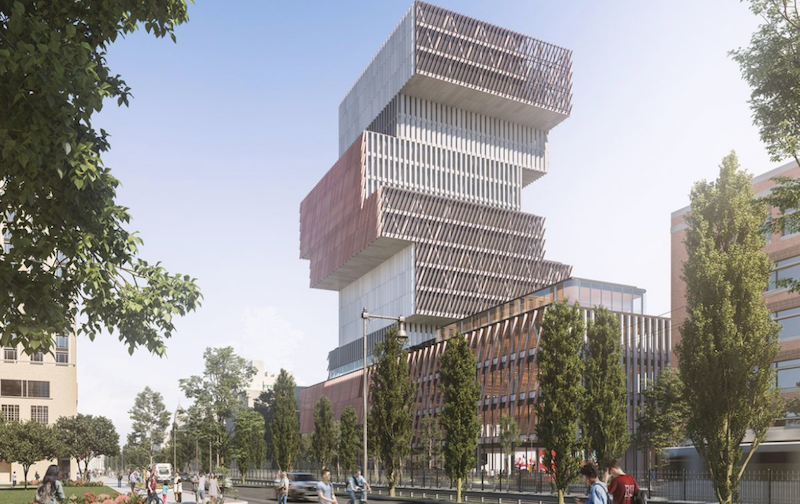The design of Boston University’s Data Science building is sure to turn some heads when it completes in 2022. The 17-story, 345,000-sf building will resemble a stack of books rising up from a podium on the university’s central campus. For the first time, BU’s mathematics, statistics, and computer science departments will be under one roof, maximizing collaboration, interaction, and interconnectivity.
The building’s transparent, porous podium will occupy the entire width of the site to complete the streetscape and generate maximum group floor animation on Commonwealth Avenue. It will rise four-stories and accommodate the larger programmatic volumes and offer a series of zones for interaction, including the Cafe, the Cascading Stair, the Street Studio, and the Fireplace Lounge.

Atop the podium will sit an additional 13 floors, each one slightly off center from the one below to create the stack of books aesthetic. Floors three through five will house the mathematics and statistics department (the fifth floor will also have a lunch space and meeting rooms). Floors six through 10 will comprise mainly space for the computer science department. The interdisciplinary Hariri Institute will be located on the top six floors, with floors 11 and 12 housing administrative offices.
See Also: Denning House completes at Stanford University

The building will include a series of terraced platforms for small group interaction, whiteboard walls, and a collaboration ramp stippled with gathering spaces.
On the team: BRA (MEP), Entuitive + LeMessurier (structural engineer), Richard Burck (landscape architect), and Nitsch Engineering (civil engineer). Construction is expected to begin this spring.

Related Stories
| Jun 12, 2014
Austrian university develops 'inflatable' concrete dome method
Constructing a concrete dome is a costly process, but this may change soon. A team from the Vienna University of Technology has developed a method that allows concrete domes to form with the use of air and steel cables instead of expensive, timber supporting structures.
| Jun 11, 2014
5 ways Herman Miller's new office concept rethinks the traditional workplace
Today's technologies allow us to work anywhere. So why come to an office at all? Herman Miller has an answer.
| Jun 9, 2014
6 design strategies for integrating living and learning on campus
Higher education is rapidly evolving. As we use planning and design to help our clients navigate major shifts in culture, technology, and funding, it is essential to focus on strategies that help foster an education that is relevant after graduation. One way to promote relevance is to strengthen the bond between academic disciplines and the campus residential life experience.
| May 29, 2014
7 cost-effective ways to make U.S. infrastructure more resilient
Moving critical elements to higher ground and designing for longer lifespans are just some of the ways cities and governments can make infrastructure more resilient to natural disasters and climate change, writes Richard Cavallaro, President of Skanska USA Civil.
Sponsored | | May 27, 2014
Grim Hall opens the door to fire safety with fire-rated ceramic glass
For the renovation of Lincoln University’s Grim Hall life sciences building into a state-of-the-art computer facility, Tevebaugh Associates worked to provide students and faculty with improved life safety protection. Updating the 1925-era facility's fire-rated doors was an important component of the project.
| May 20, 2014
Kinetic Architecture: New book explores innovations in active façades
The book, co-authored by Arup's Russell Fortmeyer, illustrates the various ways architects, consultants, and engineers approach energy and comfort by manipulating air, water, and light through the layers of passive and active building envelope systems.
| May 19, 2014
What can architects learn from nature’s 3.8 billion years of experience?
In a new report, HOK and Biomimicry 3.8 partnered to study how lessons from the temperate broadleaf forest biome, which houses many of the world’s largest population centers, can inform the design of the built environment.
| May 13, 2014
19 industry groups team to promote resilient planning and building materials
The industry associations, with more than 700,000 members generating almost $1 trillion in GDP, have issued a joint statement on resilience, pushing design and building solutions for disaster mitigation.
| May 11, 2014
Final call for entries: 2014 Giants 300 survey
BD+C's 2014 Giants 300 survey forms are due Wednesday, May 21. Survey results will be published in our July 2014 issue. The annual Giants 300 Report ranks the top AEC firms in commercial construction, by revenue.
| May 10, 2014
How your firm can gain an edge on university projects
Top administrators from five major universities describe how they are optimizing value on capital expenditures, financing, and design trends—and how their AEC partners can better serve them and other academic clients.

















